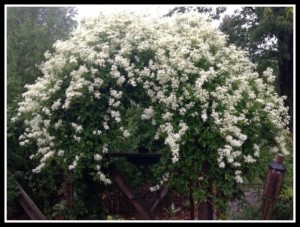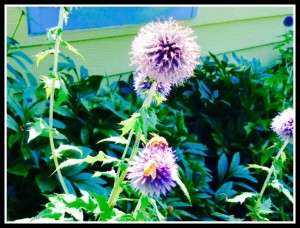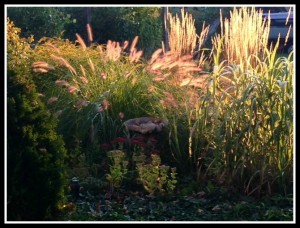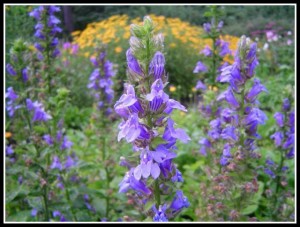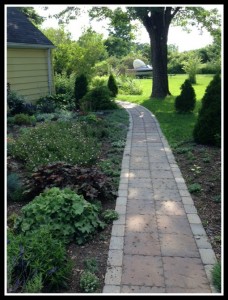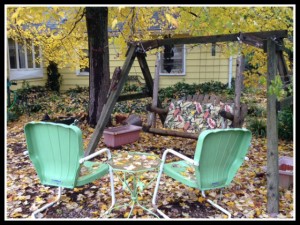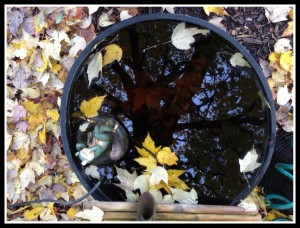Sometimes, you might wonder what you can do to make your garden even better than it already is. Here is an A-B-C list to give you food for thought. Many of these suggestions will help attract wildlife to your garden, but some of them are just for your enjoyment as well — and some are just plants that I happen to like, some native, some not.
Many more items for each letter are available. I started to do at least two per letter here, then decided the post was getting too long. Perhaps I will do another A-B-C before long.
Note: You will note that Q and X are missing. I thought for awhile and then decided to omit them.
Add an arbor, and plant climbing vines such a morning glory or clematis virginiana to climb up and bloom. It’s magical to walk under an arbor loaded with fragrant blooms to enter a garden.
B: Bees and butterflies
Bees and butterflies need sweet nectar to eat, so plant flowers and shrubs that offer them some. Make sure you have plants that bloom early and plants that bloom late, and of course, plants that bloom in the middle! Nothing makes a garden feel more alive than having these creatures as regular visitors.
C: Compost
Compost offers so many benefits, it’s hard to name them all. The compost pile recycles waste, and the finished product nourishes the soil in your garden, making for healthier, more beautiful plants. Mix it with potting soil, mix it into plant beds, and use it to top dress plants. Put a dollop into any planting hole. Make your own compost if you can, or purchase it in bulk if you cannot.
D: Daffodils
Daffodils of various kinds are such a welcome sight in early spring, after the long winter has begun to slink away. I have a row of small daffodils beside a path that are absolutely lovely early in the year. A walk down that path is a sure cure for the “winter-will-never-end” blues.
The blue balls of echinops ritro are so different from most flowers that they provide good contrast. The bees adore them, too. I have seen as many as three bees on a single 1-inch bloom, all nectaring enthusiastically.
F: Fragrance
Fragrance is essential to a wonderful garden. Some cultivars of flowers no longer have scent, but the original plants almost always do. Seek out and plant flowers that perfume the air. Great choices in the perennial world are monarda, lilies, catmint, and roses, of course. Bees and butterflies like scent, too.
Plant grasses, native if possible, in a location that allows you to see them backlit by the sun, when they are their lovliest. The constant movement of grass stems and the beautiful fall “blooms” add grace to any garden. Bigger grasses make a nice swishing sound when the wind blows, too. Annual grasses also look great in pots.
H: Herbs
Plant herbs as near to the kitchen as you can. The fragrance they provide is wonderful, and they also add flavor to your cooking. Favorites of mine include basil, chives. dill, parsley, sage, rosemary and thyme. Another wonderful plant is lemon balm. When your rub your fingers on it, you get a wonderful, lemony fragrance to enjoy.
I: Iris
Iris, the bearded kind, bloom early in spring. Yellow and purple ones close together are quite stunning to look at. I also really enjoy Japanese iris, with their dark purple blooms. We began with one of those, clearly in need of division. Division turned that one into five, and the five have morphed into about a dozen. Iris reticulata, the tiny iris that come from bulbs, are also quite wonderful, covering the ground with blue blooms in early spring.
J: Juniper
Juniper comes in several varieties, shapes, sizes and colors, and it has a wonderful fragrance. Its many forms — ranging from narrow upright shapes to low spreading varieties — can fill many roles in a garden. Juniper’s colors can range from dark green, to blue-gray, to bright green, to yellow green. Some even change to purplish-red shades in the winter.
K: Kiwi vine
If you have a sturdy pergola, plant kiwi vine to grow up and over it. This vine leafs out early, and it’s leaves look as though they have been dipped in pink paint. Later in the season, the leaves will be tipped with white. It’s a beautiful plant in fall, too, as leaves turn shades of red and orange.
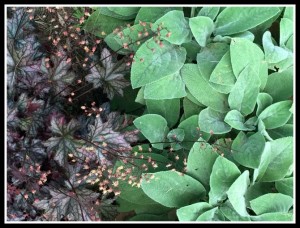 L: Leaves of Many Colors, Shapes, Sizes, and Textures
L: Leaves of Many Colors, Shapes, Sizes, and Textures
Leaves come in all shapes and sizes, and in a variety of colors and textures, too. Plant at least one plant with giant leaves — more if you can. Favorites in my garden are rhubarb, rogersia, and Sum and Substance hosta. If possible, plant a big-leaved plants near a plant with much smaller, finer leaves. The contrast will be wonderful.
M: Mystery
Strive to have a hidden corner or two in your garden. A place that is normally invisible from the usual vantage points. A place where, when you turn a corner and see it, you always feel a little stab of delight.
Plant native plants when you can, as they seem to attract more birds, bees, and butterflies than non-natives do. This does not mean that you must plant only natives, but try to have a good selection of them scattered through the garden. The plants in the photo are great blue lobelia, a great plant for a lightly shady and moist area.
O: Ostrich ferns
Ostrich ferns are a lovely addition to a shady area. They grow tall and will spread when happy. Midwest Foraging by Lisa M. Rose tells me that I can harvest their fiddleheads in the early spring to include in a stir fry, a salad, or a pasta dish.
Pathways make it easier to navigate a garden, and they invite people to walk down them. Especially appealing are pathways that turn a corner or pass a shrub that hides what lies beyond. The pathways in Serendipity Gardens are either mulch or concrete tiles, but you can make a path out of other materials as well.
R: Rhubarb
Rhubarb is a wonderful plant. It comes up with its soon-to-be giant leaves all folded up. The leaves do grow huge, and you can harvest a few stalks to make a sweet-tart rhubarb crisp. If you decide to let the plant bloom, the blooms are spectacular.
Have seats in your garden. Scatter benches and chairs here and there where a good view or cool shade awaits. The seats will invite visitors to sit awhile. Be sure to take time yourself to just sit and admire what you have helped create. A swing is an especially nice addition.
T: Tomatoes
Even if you don’t grow other veggies, tomatoes are a great addition to a garden. Have a big “Grab and Go” pot by your back door filled with cherry or Sungold tomatoes. Kids and adults alike enjoy picking a ripe fruit and popping it into their mouths as they pass this treat. Other tomatoes add to the garden, too. Choose some heirlooms and enjoy their interesting colors and shapes. Nothing tastes much better!
U: Uniqueness
Make the garden your own by adding art, sculpture, or old pieces you find at a resale shop or yard sale. Don’t be afraid to copy what you see in a magazine, but don’t be afraid either to do something in the garden that you have never seen. All that matters is that you like it.
V: Vegetables
Vegetables from the garden look pretty growing — and they offer taste and nutrition that no store-bought veggie can match! You can plant them in dedicated beds, or you can mix them in with other plants. Kale, for instance, looks lovely no matter where it grows.
Water adds wonder to any garden. It can be a pond, a simple water feature such as this one here, or even a birdbath, kept clean and full of water. Moving water adds a soothing sound and creates plays of light and shadow. If you are lucky, it will also attract a few frogs.
Y: Yarrow
Native yarrow just won’t quit, and it attracts bees and butterflies. Cultivars come in a variety of colors that look great in June and early July.
Z: Zinnias
Zinnias are wonderful flowers that come in different shapes and sizes and bloom all season long. They add cheerful pops of color where you need it. Plant some in your garden.
Like this post? Sign up to receive an email each time a new post is available. We will never loan, sell or rent your email address — that’s a promise! Please use the buttons below to share with others.
